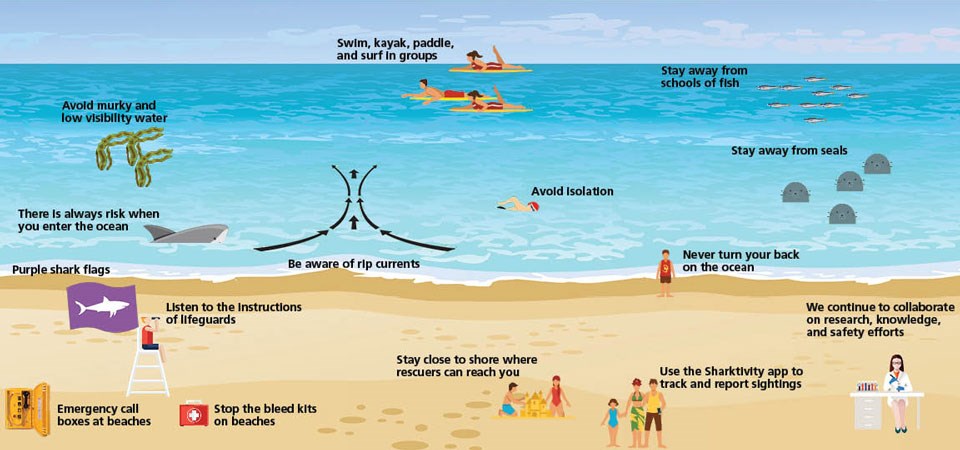Beach Safety: Sharks, Rip Currents, Undertows, and Your Wellbeing
The ocean, bay and marshes of Cape Cod are an amazing recreational opportunity. Recently there has been an increase in great white shark activity in our waters. This isn’t welcome news, but with caution and common sense you can enjoy the beaches.
The recent rise in the number of sharks in the ocean has been characterized as both a tragedy and a triumph. Some beachgoers are concerned about recreational activities, while conservationists look at the comeback of sea mammals as a victory for conservation.
Whichever way you look at the sharks, seals, and other mammals, the people of Cape Cod are working to ensure your vacation is a safe and pleasant one. Click to view a shark safety video.

The illustration above shows simple steps for safety at the beach.
The number one safety rule is to avoid seals! Seals are the primary food for sharks, and they will seek a seal even in shallow water.
DON’T go into water deeper than your chest, and don’t be in the water alone whether swimming, paddling, or kayaking. Schools of fish are very interesting but are food for seals and will attract unwanted attention. Don’t go where you can’t see the bottom, wear shiny objects, splash, or otherwise attract underwater attention. Watch for Rip Tides and Undertows!
DO listen to lifeguards, pay attention to the purple shark flags, use the Sharktivity App to be aware of, and report shark sightings, be aware of your surroundings, note the location of beach call boxes, and “Stop the Bleed” emergency kits.
RIP CURRENTS and UNDERTOWS: Over a 10-year average, rip currents and undertows cause 46 deaths annually. A rip current, also called a riptide, is a surface current that flows away from the shore, perpendicular or at an acute angle to the shoreline. Whereas an undertow occurs underneath shore-approaching waves. Fighting either of these strong currents can exhaust a swimmer, and recommendations are to swim parallel to the shore or to float along with the tide. If caught in a rip current, remain calm. This is another strong reason for not swimming alone!
The Cape Cod community invests deeply in safety measures at our shores. Eastham, the local town governments, Barnstable County, the State of Massachusetts and the U.S. Federal government in conjunction with the Cape Cod National Seashore, in response to the increase in shark activity, have explored many possible enhancements to procedures, and have invested in new equipment and safety programs. The Cape Cod National Seashore continues its “Purple Flag” warning, and has invested in enhanced signage, and brochures. The Seashore, along with towns, has installed Emergency Phones that are instantly connected to 911 when the receiver is lifted.
Eastham has assessed vulnerabilities, and as a result, has increased cell coverage at the ocean and bay beaches. Eastham has also purchased a “Surf Boat” fully equipped with rescue gear that can be launched in low water and quickly reach a person in distress. These steps, along with the “Stop the Bleed” program, are anticipated to increase the safety of our waters. The Town continues to participate in studies of next-generation technologies that may provide additional safety.
Eastham’s number one concern is always for the safety of everyone wishing to enjoy our magnificent beaches.
Additional Reading:
Cape Cod National Seashore
Cape Cod Great White Shark Safety
FAQ about Sharks and Public Safety
Atlantic White Shark Conversancy
Boston Globe Article
Cape Cod Readies for Tourist Season
Rip Currents
NOAA Rip Current Education and Facts












